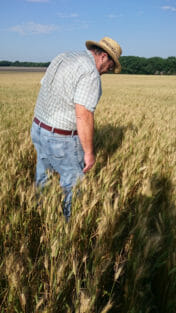Meet Robin and Kelly Griffeth — and Sneak a Peek at Their Conference Sessions!
When you hear the phrase “solar collector,” what comes to mind? If you’re like me, the image of shiny black panels arrayed on a sunny plain, or the roof of a house — or even adorning a highway sign — is what pops to mind first.
 The phrase certainly never conjured an image of row crop plants growing in a farmer’s field.
The phrase certainly never conjured an image of row crop plants growing in a farmer’s field.
That is, until I read the brochure for Practical Farmers of Iowa’s 2016 annual conference, “Farmers Teaching Farmers” (Jan. 22-23, in Ames), and the description of a workshop Robin and Kelly Griffeth will be leading called “Living Plants as Solar Collectors.”
Robin and and his son Kelly raise corn, soybeans, wheat, grain sorghum and sunflowers on 3,700 acres near Jewell, Kansas, in the north-central part of the state. They have been continuous no-tillers for 20 years, and strive to keep living roots in the soil as close to 365 days a year as possible.
For them, their crops are the original solar arrays. After conversing more with Robin, it makes perfect sense! (I can even see acres of sunflowers turning their heads to follow the sun — just like the high-tech solar arrays out in the desert).
Here’s what Robin had to say to a couple of questions I had.
Note: He and Kelly will delve much more deeply into these topics (and others!) during three conference sessions they’re leading — so be sure to attend if you want to learn more! Visit our 2016 conference page for full details.
What does it mean to think of your plants as solar collectors and how that has changed your management?
ROBIN: “In all reality, our fields are simply large solar collectors. The sun’s energy is going to be used in one of two ways; “Photosynthesis;” which is CONSTRUCTIVE! or “heat,” which can be very DESTRUCTIVE!
“In the presence of living planst, photosynthesis converts the sun’s energy into life-giving food for us, as well as livestock, wildlife and soil biology — CONSTRUCTIVE! In the absence of living plants, however, the sun’s power is instead used to heat the soil, which not only dries the soil but can actually begin to kill vital soil biology — DESTRUCTIVE!
“Sadly, we have not always realized these two facets of solar energy. Through monoculture cropping systems, we have experienced the “destructive” aspect more than we would like to admit. However, we now realize that our management determines how solar energy is going to be used.”
How did you get started with companion crops, and what are some of the benefits and challenges of planting them?
ROBIN: “Our journey with companion crops began quite by accident. A simple ‘error,’ of running out of seed before I ran out of field, caused us to have to scrounge around for different species of seed to fill the gap. Sunflower seed being one of those species, thrived and was harvested for grain, and the rest was left for cover.
“From that ‘error,’ we learned to take ‘conventional wisdom’ with a grain of salt, because this was not supposed to work, but it did.
“These results aroused our curiosity, and from there our journey has expanded to different crop mixes, most with unexpected results; some good, and some bad. Whether good or bad, we always learn something.
“There are many unknowns with companion crops as to how these plants work together as a community rather than competitively. Diversity of species seems to be a healthier choice for the plants as well as the soil, and ultimately us.
“Our moto is: ‘We learn more from our mistakes than we do from our successes.’
“The biggest challenge we face is our own minds. GET OUT OF THE BOX.”
Read More
If you’d like to learn more about Robin and Kelly Griffeth’s farm practices, have a read through these articles:
- “Companion Cropping Boosts No-Till Profits, Soil Health” — (No-Till Farmer, June 1, 2013)
- “Farmer Panel: Cover Crops Help Store, Rather Than Steal Plains Soil Moisture” — (No-Till Farmer, Feb. 6, 2015)
- “Andy Howard’s Nuffield Scholarship Journey”
- “Their Sunflower Crop Likes Companionship” — (Sunflower Magazine, December 2014)
